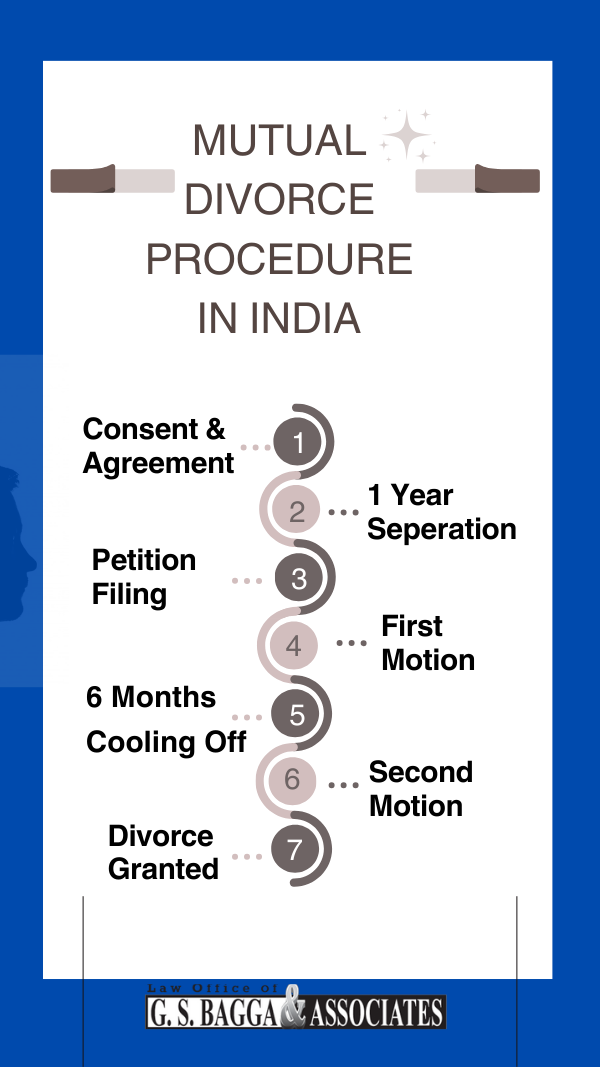Marriage in India is often celebrated as a joyous union, a lifelong commitment woven into the fabric of tradition and family. But sometimes, even the strongest threads can fray, leading to an unexpected turn in your path. Are you standing at this crossroads? If yes, then remember, you’re not alone. If you’re planning for mutual divorce and have a lot of concerns or queries, then here’s a quick guide on the procedure for divorce by mutual consent in India. Read on to learn:
- What Is Mutual Consent Divorce in India?
- Mutual Consent Divorce Process In India
- Mutual Consent Divorce Cases In India
- Mutual Divorce Procedure For Muslims And Christians In India
- Formalities For Mutual Divorce In India
- Things To Consider Before Mutual Divorce
- Documents Required For Mutual Divorce In India
- How Long Does Mutual Consent Divorce Take?
- Can You File Mutual Divorce Alone?
What Is Mutual Consent Divorce In India?
Divorce by mutual consent in India is a legal process for dissolving a marriage where both spouses agree to end the marriage and meet certain legal requirements.
It’s a faster and less stressful alternative to contested divorces, which involve legal battles and a proper understanding of the procedure for divorce by mutual consent in India.
Procedure For Divorce By Mutual Consent In India

Section 13B of the Indian Marriage Act, enacted in 1976, asks for divorce by mutual consent if both spouses (married before or after the marriage (Amendment) Act, 1976) agree to separate amicably.
Divorce by mutual consent in India is the easiest, fastest, stress-free, and cheapest way to get a divorce. It involves the following key stages:
Stage 1: Joint Petition for Mutual Divorce
A joint petition consists of a declaration by the parties that they have agreed to separate and do not wish to remain together as a married couple.
Where is the joint application filed?
- The petition is filed in the family court in the district,
- Where did the couple last lived, or
- Where the marriage took place, or
- Where the spouse currently lives.
Conditions to meet:
Spouses must prove that they have lived apart for at least one year immediately before the registration date.
Living apart means that the parties do not want to consummate the marriage, even if they live under the same roof, they cannot live together, and both spouses agree to have a mutual divorce.
The husband should have agreed to two more conditions:
1. Matters of alimony – Alimony can be given either by the husband to the wife or vice versa as a one-time payment or as a periodic payment. The parties should agree on a maximum or minimum amount of alimony.
When deciding on maintenance or alimony, the court must consider many factors, such as custody of the child, the financial status of the party, the status of the parties, income and assets, amount of maintenance, etc.
Also Read – Can A Wife Claim Her Husband’s Property During Divorce?
2. Custody of children – If the custody can be joint custody, where the children have regular contact with both parents.
In addition to physical custody, parents share legal custody of the child in matters of education, religious beliefs, health, etc., where they can jointly decide on matters affecting their lives.
However, the child lives with the parent who has physical custody.
Stage 2: Petitions
After filing the petition and on the date set by the court, the spouses must appear in court. The court examines the application and other related documents and records the oath of the parties after approval.
At this stage of the mutual consent divorce process in India, the court must do everything possible to save the marriage, and if there is no possibility of reconciliation, the court should proceed to the next stage.
Stage 3: Procedure Followed in Court
After the statements are recorded, the court issues an order on the first petition. The court postpones the hearing of the case for 6 months (maximum 18 months) from the date of submission of the request after the first request is satisfied, and before 18 months have passed, the parties can present a second request confirming their request consent.
If at the end of the reconciliation phase, there is no possibility of further reconciliation between the parties and the parties do not want to live together as spouses, the spouses can submit a new request. If the parties do not submit a second request, the court will not take the case further.
Stage 4: Judgment
If the court is satisfied with the arguments presented by the mutual divorce lawyer that the allegations in the petition are true, it can issue a divorce decree.
However, if the court can’t figure out if the consent of the concerned party was coerced or if there was coercion or fraud involved, the injured party can appeal the court’s decision.
So, these are the four stages involved in the procedure for divorce by mutual consent in India.

Supreme Court Cases On Mutual Divorce In India
1. Irretrievable Breakdown Of Marriage
Shilpa Sailesh vs Varun Sreenivasan (2023): This landmark case recognized the “irretrievable breakdown of marriage” as a ground for divorce, even though it’s not explicitly mentioned in the Hindu Marriage Act (HMA).
2. Living Separately For One Year
Hitesh Bhatnagar vs Deepa Bhatnagar (2011): Confirmed that separation for one year is mandatory under Section 13B of the HMA for mutual divorce. However, exceptions in cases of exceptional hardship or depravity might be considered.
3. Procedure And Waiting Period
1. Joint Petition & Motion:
Ashok Hurra vs Rupa Ashok Hurra (1997): Established the requirement for a joint petition by both spouses under Section 13B(1) and a subsequent motion for decree after six months under Section 13B(2).
2. Waiver of Waiting Period:
1. Amit Kumar vs Suman Beniwal (2021): Emphasized the importance of the six-month cooling-off period but granted its exceptional waiver under Article 142 in specific situations.
2. T.P. (Crl) No. 96 of 2014 (2023): A pending case before a five-judge bench will further consider the scope of waiving the waiting period under Article 142.
4. Khula Under DMMA
Mohammed Yusuf Khan vs. Saboomi Begum (1985): upheld the wife’s right to obtain khula under DMMA.
5. Six-Month Cooling-Off Period
Christian Welfare Home (Hoshiarpur) vs. Ramesh Chand & Ors. (1985): Reiterated the six-month cooling-off period for mutual consent divorce under ICMA.
Mutual Consent Divorce Procedure For Muslims And Christians In India
While the procedure for divorce by mutual consent in India generally follows similar principles across different communities, there are some nuances specific to Muslims and Christians due to the application of different personal laws:
Mutual Consent Divorce Laws For Muslims:
- Applicable law: Dissolution of Muslim Marriage Act, 1939 (DMMA) and Muslim Women (Protection of Rights on Divorce) Act, 1986 (MWPRD).
- Grounds for divorce: Husband’s Talaq Wife can seek divorce if the husband pronounces talaq (instantaneous repudiation) without her consent or in violation of Islamic principles.
- Khula: The wife can initiate divorce by offering the husband a “khula” or redemption payment.
- Mutual Consent: Divorce by mutual consent is recognized under Section 2(ii) of the DMMA, however, the specific procedure might differ slightly.
Divorce Procedure:
- Joint application: Both spouses file a joint application for dissolution of marriage in a family court.
- Reconciliation Efforts: The court may appoint a conciliator to attempt reconciliation.
- Khula agreement: In the case of Khula, agreement on an acceptable “khula” amount is essential.
- Dissolution decree: If reconciliation fails and the court is satisfied with the proceedings, it will grant a decree of dissolution.
Also Read – What Should I Do If My Spouse Does Not Wish To Divorce?
Mutual Consent Divorce Laws For Christians:
- Applicable law: Indian Divorce Act, 1869 (IDA) and Indian Christian Marriage Act, 1872 (ICMA).
- Grounds for divorce: Adultery by either spouse is a ground for divorce under both IDA and ICMA.
- Desertion: Desertion for two years or more is a ground under IDA and ICMA.
- Cruelty: Cruelty of a nature rendering it unsafe for the other spouse to continue cohabitation is a ground under both laws.
- Mutual Consent: Mutual consent is recognized as a ground for divorce under Section 28 of ICMA.
Divorce Procedure:
- Joint petition: Both spouses file a joint petition for dissolution of marriage in a district court.
- Cooling-off period: A mandatory six-month cooling-off period applies, similar to other communities.
- Evidence of Separation: Proof of living separately for one year or more is required.
- Decree nisi: After six months, if everything is in order, the court grants a decree nisi, which becomes absolute after six months, finalizing the divorce.
Also Read – Divorce Mediation vs. Litigation: Which Option Is Right for You?
Legal Formalities For Mutual Divorce In India
- Both spouses must agree to the divorce (the divorce will not be enforceable if one of the parties does not wish to move forward with it).
- To end the marriage, your partner must provide you with a written notice of their intention. You can accomplish this via email, fax, or mail. Your divorce will not be enforceable if your spouse fails to provide you with this notification.
- The couple must have been married for at least six months and have lived separately for at least six months before filing for a mutual divorce.
- The couple must meet all financial obligations that they accrued during their marriage.
- The couple must live apart for at least six months after the mutual divorce is finalized to preserve any property or marital assets that may be divided between them.
- Throughout the divorce process, both parties are required to be represented by counsel. This might be a mediator or a lawyer.
- The date of the divorce hearing will be determined by the court.
- Both parties will get a decree of dissolution of marriage following the court’s ruling.
Things To Consider Before Mutual Divorce

Opting for a divorce by mutual consent in India can be a complex and emotionally taxing decision. While it offers a faster and more amicable process compared to contested divorces, it’s crucial to carefully consider all aspects before taking any action. Here are some key things to ponder before embarking on this path:
Emotional Considerations:
- Are you certain about the decision? Have you explored all possibilities for reconciliation and marriage counseling? Ensure your decision stems from genuine reasons, not temporary emotions.
- Communicate openly and honestly: Discuss your reasons openly and honestly with your spouse. Make sure that both of you are in agreement about ending the marriage.
- Prepare for emotional turmoil: Ending a marriage, even when it’s mutual, can be emotionally draining. Be prepared for the grieving process and seek support from friends, family, or a therapist.
Legal and Financial Considerations:
- Consult a mutual consent divorce lawyer: Seek professional legal advice to understand the legal implications, procedures, and your rights and obligations in a mutual divorce in India.
- Financial settlement: Discuss and agree upon a fair financial settlement, including division of assets, debts, and alimony (if applicable). Document everything in a legally binding agreement.
- Child custody and visitation: If you have children, decide on their custody and visitation arrangements. Consider their best interests and emotional well-being.
Documents Required For Mutual Divorce In India
- Address proof of both parties.
- Details of professions and present income of both parties.
- Certificate of Marriage.
- Family background information.
- Proof of marriage- photographs, videos, and other documents..
- Evidence to prove that the husband and wife have been living separately for more than one year.
- Evidence proving failed attempts of reconciliation.
- Income tax statements.
- The living standard of the claimant.
- Details of property and assets of both parties.
- Other documents may also be required, depending upon the facts and circumstances of the particular case.
How Long Does Mutual Consent Divorce Take In India?
The quickest divorce procedure is one that is accomplished by mutual consent divorce, which typically takes between six months and two years to complete . The length of time, however, can differ based on the aspects of each situation.
The court may, nonetheless, decide to grant a divorce in particular circumstances without requiring a cooling-off period. In most cases, these situations entail extraordinary circumstances, including when one of the partners is seriously ill or when their lives are in danger.
Can You File Mutual Divorce Alone?
No, a mutual divorce in India cannot be filed alone. It requires the consent and active participation of both spouses, meaning both husband and wife need to file the petition for divorce jointly. This is outlined in Section 13B of the Hindu Marriage Act, 1955, which governs divorce by mutual consent in India.
Also Read – Is One-Sided Divorce Possible?
The Takeaway
While ending the marriage can be emotionally challenging, opting for mutual divorce in India provides a dignified and respectful way forward. With a six-month cooling-off period and two court appearances, the procedure for divorce by mutual consent in India allows both spouses to have enough time for reflection and ensures a well-considered decision.
If you and your spouse are considering divorce by mutual consent, then consulting a qualified mutual divorce lawyer, accessing information resources, and prioritizing open communication can significantly ease the process. Avail the right legal support for a smoother transition!
Do you have any more queries regarding the procedure for divorce by mutual consent in India? Drop a comemnt below.

Disclaimer: This post was originally published on March 16, 2022, and was updated on February 15, 2024, to reflect current information. We strive to ensure accuracy and relevance in our content updates.


